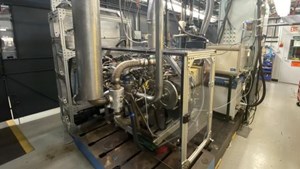News
Argonne, Achates Power break new ground on H2-powered engines
Invented more than 100 years ago, the opposed-piston engine had its heyday during World War II, powering submarines and aircraft carriers. Despite its exceptional fuel efficiency, the engine never took hold on a broader scale, primarily due to tightening emissions standards.
In recent years, advanced technology and engineering have given the opposed-piston engine new life as scientists explore its potential role in a zero-carbon transportation system.
Specifically, scientists at the U.S. Department of Energy’s (DOE) Argonne National Laboratory are partnering with Achates Power, a leader in designing opposed piston, two-stroke compression ignition engines, to develop a H2-powered engine primarily for long-haul commercial vehicles.
“H2 may be the best fuel for truly sustainable long-haul transportation. Argonne’s successful demonstration with carbon-free H2 combustion will be an important step towards decarbonizing the mid-duty, heavy-duty freight sector,” said Essam El-Hannouny, Argonne principal engineer
“Argonne scientists recently began testing the H2-powered engine in a groundbreaking demonstration that yielded promising results,” said Essam El-Hannouny, Argonne principal engineer.
“For the first time at Argonne, we demonstrated that the opposed-piston engine can run on H2 and produce power,” El-Hannouny said. “We are in the early stages, but the testing provides the data we need to make changes to the combustion mode or other parts of the engine to improve performance.”
H2 is a versatile fuel that can be produced from low- and no-carbon resources like wind and solar energy. It emits no carbon dioxide when burned.
A longtime leader in H2 research and technology, Argonne is uniquely suited for the project. Argonne’s research facilities include a single-cylinder opposed-piston engine platform with a newly designed and optimized combustion chamber for medium- and heavy-duty engine research. Facilities also include a H2 delivery and storage system.
The project builds on a longstanding relationship between Argonne and Achates. The venture marks the first time Achates is testing H2 on its engine, said Laurence Fromm, executive vice president and chief commercialization officer at Achates Power.
“In the transition away from fossil fuels, there is a growing focus on developing and refining H2 combustion in general and H2 combustion in opposed-piston engines specifically,” Fromm said. “In partnering with Argonne, we can explore some of the combustion concepts developed at Achates. We can make refinements based on data generated during testing. Our goal is to develop an efficient, cost-effective H2 combustion opposed-piston engine that could be transformational for the transportation industry.”
“This is not a completely new idea. But recent technologies like electronic controls, electronic fuel injection and sensors that provide critical feedback can be applied to advance the opposed-piston engines of today,” said Douglas Longman, Argonne’s group manager, Advanced Power Systems Research. “The opposed-piston engine has an enormous potential for decarbonization by running on H2 fuel.”
H2-powered engines deliver power, efficiency, cost savings. The advanced opposed-piston engine has numerous advantages for H2 combustion compared to conventional engines. One advantage is the simplicity of its design. The innovative piston architecture refined by Achates Power sets two pistons moving in opposition in one cylinder. The design eliminates cylinder heads, which are a major cause of heat loss and inefficiency in conventional engines.
“This is significant because H2 fuel has high reactivity and low ignition energy,” El-Hannouny said.
The engine’s two-stroke combustion cycle produces twice as many power strokes per crankshaft revolution as a standard four-stroke engine. In this way, it delivers more power. The engine is also lighter, less expensive and easier to build.
Electric vehicles (EVs) dominate the zero-carbon transportation market for cars. The H2-powered opposed-piston engine can fill a unique niche in powering hard-to-electrify vehicles that travel long distances.
“H2 may be the best fuel for truly sustainable long-haul transportation,” El-Hannouny said. “Argonne’s successful demonstration with carbon-free H2 combustion will be an important step toward decarbonizing the mid-duty, heavy-duty freight sector.”
Achates is targeting its H2-powered engine for medium- to large-size commercial trucks, off-road vehicles for industries like mining and agriculture, and military vehicles.
Computer modeling aids engine optimization. Argonne’s testing is just getting under way. Achates will use the combustion and emission data generated during initial testing to update its computer models. The goal is to refine the engine design and improve combustion strategies. Achates engineers work remotely and on-site at Argonne to assist with engine calibration and monitoring.
Ming Huo, Achates Project Manager, is developing computer and simulation models to process and analyze data. The Argonne-Achates team is just beginning to tap the potential of the H2-powered opposed-piston engine, Huo said.
“Our goal is to demonstrate the capability of the opposed-piston engine to run H2 and reach the efficiency, power density and torque of diesel-powered engines, at the same time we are eliminating greenhouse gas emissions,” Huo said.
Argonne’s expertise and state-of-the art facilities are critical to bringing the Achates H2-powered engine into the marketplace, Fromm said.
“Achates has been working with Argonne for over a decade and they are the perfect partner for this project,” Fromm said. “Argonne has extensive experience with H2 combustion. And not just on opposed-piston engines, but on conventional engines as well. Argonne’s unique capabilities and depth of experience are essential to the success of the project.”
The Argonne/Achates project was funded through DOE’s Vehicle Technologies Office, in the Office of Energy Efficiency and Renewable Energy, as part of DOE’s $133 MM in funding for new and innovative advanced vehicle technologies research.


